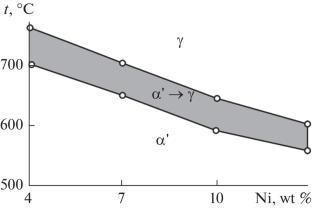Abstract—This article presents the results of studies of the structure and mechanical properties of high strength austenite chromium-free dispersion hardened Mn–Ni–V–C steel with the yield stress of at least 700 MPa; its composition and hardening method have been selected with consideration that the steel should meet the requirements of high strength and non-magnetization as well as possess a value of electrode potential in chloride media preventing galvanic corrosion during the contact with ferromagnetic low alloy and carbon steels. It has been established that, upon addition of 1–2% Cu to Mn–Ni–V–C steel, on the phase diagram of Fe–Ni–Mn, the region of existence of the γ phase is broadened, and the two phase γ + α region is narrowed and displaced toward lower Mn contents, thus increasing the austenite stability against martensite transformation upon cold deformation. Numerical assessment of the influence of alloying austenite elements Ni, Mn, and Cu on the critical extent of cold plastic deformation leading to formation of deformation martensite in steel is proposed. The temperature range of reverse transformation of this martensite into austenite during annealing has been determined as a function of nickel content in steel. The regularities of dissolution upon heating for quenching and deposition of particles of the hardening carbide phase VC have been studied for dispersion hardened steel with the following composition: 10% Mn; 10% Ni; 2% Cu; 0.3–0.4% C; ~1.4% V. It has been demonstrated that the maximum strength is achieved after quenching from 1150°C and aging at 650°C for 15 h. The cyclic durability of steel increases with the aging duration from 0.7 to 10 h; however, the strength aging close to the maximum leads to a decrease in this performance. Taking into account the performed studies of austenite stability, static and cyclic strength, and durability, the optimum interval of steel alloying with nickel, manganese, and copper has been substantiated, and the optimum mode of thermal tre-atment providing a combination of high strength with good plasticity and toughness of steel has been det-ermined.



